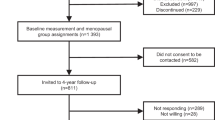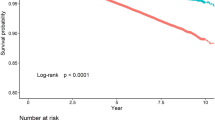Abstract
OBJECTIVE: To investigate the differential association of cigarette smoking with energy balance in African-American and white premenopausal women.
DESIGN: Cross-sectional study of energy balance, weight, and smoking in women.
SUBJECT: A total of 374 women: 191 African-American (mean age=29.8±6.5 y) and 183 white women (mean age=28.9±7.1 y).
MEASUREMENTS: Weight, cigarette smoking habits, resting energy expenditure, dietary intake, and physical activity.
RESULTS: There were no significant differences in dietary intake by race or smoking status. The model for physical activity was significant (P=0.0004), with body mass index (BMI) having the largest effect on activity (P<0.001). Smoking status was related to activity, with the heaviest smokers reporting more activity than nonsmokers (P=0.008) or light smokers (P=0.028). The model for resting energy expenditure (REE) was significant (P<0.0001), with the largest again being BMI (P<0.001). There was also an interaction between ethnicity and smoking status (P<0.0001) such that African-American nonsmokers and light smokers tended to have lower REE than several other groups, most often the African-American moderate heavy smokers. The model for BMI was significant (P<0.0001) with an interaction for ethnicity and smoking status (P=0.0009). African-American nonsmokers and light smokers had significantly higher BMIs than most of the other groups.
CONCLUSION: African-American women who were the heaviest smokers had a lower adjusted BMI than the heaviest smoking white women. This effect, at least partially, may be related to an increased REE in the African-American smoking women. While energy intake did not appear to be important in this relationship, energy expended in physical activity appeared to be increased with smoking, as was REE.
This is a preview of subscription content, access via your institution
Access options
Subscribe to this journal
Receive 12 print issues and online access
$259.00 per year
only $21.58 per issue
Buy this article
- Purchase on Springer Link
- Instant access to full article PDF
Prices may be subject to local taxes which are calculated during checkout





Similar content being viewed by others
References
U.S. Department of Health and human Services. Women and smoking. A report of the Surgeon General — 2001. U.S. Department of Health and Public health Service, Center for Disease Control, Office on smoking and Health: Rockville, MD; 2001. [accessed at: http://www.cdc.gov/tobacco/sgr_forwomen.htm; accessed on 7/25/01]
Klesges RC, Klesges LM . The relationship between body mass and cigarette smoking using a biochemical index of smoking exposure. Intl J Obes Relate Metab Disord. 1993; 17: 585–591.
Klesges RC, Ward KD, Ray JW, Cutter G, Jacobs DR, Wagenknecht LE . The prospective relationships between smoking and weight in a young, biracial chohort: The Coronary Artery Risk Development in Young Adults Study. J Consult Clin Psychol 1998; 66: 987–993.
DeBon M, Klesges RC, Klesges LM . When should you measure metabolic rate? Ann Behav Med 1993; 15: S67.
Eck LH, DeBon M, Klesges RC, Preacher-Ryan H, Klesges LM . Gathering dietary intake during the menstrual cycle. Ann Behav Med 1994; 16: S165.
Albanes D, Jones DY, Micozzi MS, Mattson ME . Associations between smoking and body weight in the US population. Analysis of NHANES II. Am J Publ Health 1987; 77: 439–444.
Drewnoski A . Diet image: a new perspective on the food-frequency questionnaire. Nutr Rev 2001; 59: 370–372.
Block G, Hartman AM . Issues in reproducibility and validity of dietary studies. Am J Clin Nutr 1989; 50: 1133–1138.
Dennison DD, Dennison KF, Addman M, Groeger LA . The DINE system: nutrient analysis, diet improvement software for health care settings. In: Dayhoff R (ed). Proceedings of the 11th annual symposium on computer applications in medical care, November 1–4, 1983.
Baecke JAH, Burema J, Frijters JER . A short questionnaire for the measurement of habitual physical activity in epidemiological studies. Am J Clin Nutr 1982; 36: 936–942.
Montoye HJ, Kemper HCG, Saris WHM, Washburn RA . Measuring physical activity and energy expenditure. Human Kinetics: Champaign, IL; 1996.
Philippaerts RM, Westerterp KR, Lefevre J . Comparison of two questionnaires with a tri-axial accelerometer to assess physical activity patterns. Int J Sports Med 2001; 22: 34–39.
Jacobs Jr DR, Ainsworth BE, Hartman TJ, Leon AA . A simultaneous evaluation of ten commonly used physical activity questionnaires. Med Sci Sports Exerc 1993; 25: 81–91.
Isbell TR, Klesges RC, Meyers AW, Klesges LM . Measurement reliability and reactivity using repeated measurements of resting energy expenditure with a face mask, mouthpiece, and ventilated canopy. J Parenter Enteral Nutr 1991; 15: 165–168.
Weir JB de V . New methods for calculating metabolic rate with special reference to protein metabolism. J Physiol 1949; 109: 1–9.
Istvan JA, Cunningham TW, Garfinkel L . Cigarette smoking and body weight in the Cancer Prevention Study I. Int J Epidemiol 1992; 21: 849–953.
Rasky E, Stronegger W-J, Freidl W . The relationship between body weight and patterns of smoking in women and men. Int J Epidemiol 1996; 25: 1208–1212.
Klesges RC, Zbikowski SM, Lando HA, Haddock CK, Talcott GW, Robinson LA . The relationship between smoking and body weight in a population of young military personnel. Health Psychol 1998; 17: 454–458.
Istvan JA, Nides MA, Buist AS, Greene P, Voelker H . Salivary cotinine, frequency of cigarette smoking, and body mass index: findings at baseline in the Lung Health Study. Am J Epidemiol 1994; 139: 628–636.
Chitwood LF, Brown SP, Lundy MJ, Dupper MA . Metabolic propensity toward obesity in black vs white females: responses during rest, exercise and recovery. Int J Obes Relate Metab Disord 1996; 20: 455–462.
Kumanyika SK . Understanding ethnic differences in energy balance: can we get there from here. Am J Clin Nutr 1999; 70: 1–2.
Clemens LH, Klesges RC, Slawson DL, Kumanyika SK, Murray DM, Beech BM . The relationships between personal and psychosocial characteristics and underreporting of energy intake in African-American and white women (manuscript under revision).
Blackburn GL, Kanders BS (eds). Obesity, pathophysiology, psychology, and treatment. Chapman & Hall Series in Clinical Nutrition. Chapman & Hall: New York; 1994.
Kimm SYS, Glynn NW, Aston CE, Poehlman ET, Daniels SR . Effects of race, cigarette smoking, and use of contraceptive medications on resting energy expenditure in young women. Am J Epidemiol 2001; 154: 718–724.
Vander Weg MW, Klesges RC, Ward KD . Differences in resting energy expenditure between black and white smokers: implications for postcessation weight gain. Eur J Clin Nutr 2000; 54: 895–899.
Forman JN, Miller WC, Szymanski LM, Fernhall B . Differences in resting metabolic rates of inactive obese African-American and Caucasian women. Int J Obes Relat Metab Disord 1998; 22: 215–221.
Foster GD, Wadden TA, Vogt RA . Resting energy expenditure in obese African American and Caucasian women. Obes Res 1997; 5: 1–8.
Jakicic JM, Wing RR . Differences in resting energy expenditure in African-American vs Caucasian overweight females. Int J Obes Relat Metab Disord 1998; 22: 236–242.
Nicklas BJ, Berman DM, Davis DC, Dobrovolny CL, Dennis KE . Racial differences in metabolic predictors of obesity among postmenopausal women. Obes Res 1999; 7: 463–468.
Weyer C, Snitker S, Bogardus C, Ravussin E . Energy metabolism in African Americans: potential risk factors for obesity. Am J Clin Nutr 1999; 70: 13–20.
Weinsier RL, Hunter GR, Zuckerman PA, Redden DT, Darnell BE, Larson DE, Newcomer BR, Goran MI . Energy expenditure and free-living physical activity in black and white women: comparison before and after weight loss. Am J Clin Nutr 2000; 71: 1138–1146.
Carpenter WH, Fonong T, Toth MJ, Ades PA, Calles-Escandon J, Walst JD, Poehlman ET . Total daily energy expenditure in free-living older African-Americans and Caucasians. Am J Physiol 1998; 274(1 Part 1): E96E101.
Sharp TA, Bell ML, Grunwald GK, Schmitz KH, Sidney S, Lewis CE, Tolan K, Hill JO . Differences in resting metabolic rate between white and African-American young adults. Obes Res 2002; 10: 726–732.
Warwick PM, Baines J . Energy expenditure in free-living smokers and nonsmokers: comparison between factorial, intake-balance, and doubly labeled water measures. Am J Clin Nutr 1996; 63: 15–21.
Ward KD, Klesges RC, Vander Weg MW . Cessation of smoking and body weight. In Bjorntorp P (ed). International textbook of obesity. John Wiley & Sons, Ltd: London; 2001. pp 323–336.
Fiore MC, Novotny TE, Pierce JP, Hatziandreu EJ, Patel KM, David RM . Trends in cigarette smoking in the United States: the changing influence of gender and race. JAMA 1989; 261: 49–55.
Williamson DF, Madans J, Anda RF, Kleinman JC, Giovino GA, Byers T . Smoking cessation and severity of weight gain in a national cohort. N Engl J Med 1991; 324: 739–745.
Wagenknecht LE, Cutter GR, Haley NJ, Sidney S, Manolio TA, Hughes GH, Jacobs DR . Racial differences in serum cotinine levels among smokers in the Coronary Artery Risk Development in (Young) Adults Study. Am J Public Health 1990; 80: 1053–1056.
Author information
Authors and Affiliations
Corresponding author
Additional information
This work was supported by funds from the National, Heart, Lung, and Blood Institute HL50946 awarded to the first author and HL463521 awarded to the second author.
Rights and permissions
About this article
Cite this article
Clemens, L., Klesges, R., Slawson, D. et al. Cigarette smoking is associated with energy balance in premenopausal African-American adult women differently than in similarly aged white women. Int J Obes 27, 1219–1226 (2003). https://doi.org/10.1038/sj.ijo.0802400
Received:
Revised:
Accepted:
Published:
Issue Date:
DOI: https://doi.org/10.1038/sj.ijo.0802400
Keywords
This article is cited by
-
Smoking and Socio-demographic correlates of BMI
BMC Public Health (2016)
-
Smoking, oxidative stress and inflammation: Impact on resting energy expenditure in diabetic nephropathy
BMC Nephrology (2005)



